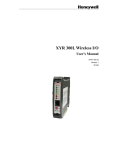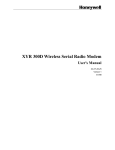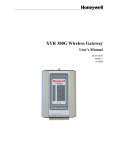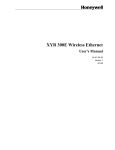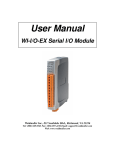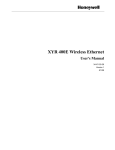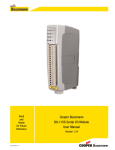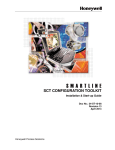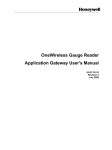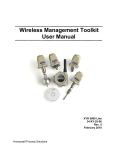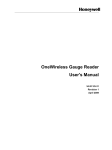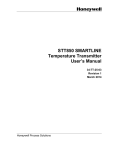Download XYR 301X Serial I/O Module - Honeywell Process Solutions
Transcript
XYR 301X Serial I/O Module User's Manual 34-XY-25-23 Version 1 5/1/2008 Notices and Trademarks Copyright 2008 by Honeywell International Inc. Version 1 May 1, 2008 While this information is presented in good faith and believed to be accurate, Honeywell disclaims the implied warranties of merchantability and fitness for a particular purpose and makes no express warranties except as may be stated in its written agreement with and for its customers. In no event is Honeywell liable to anyone for any indirect, special or consequential damages. The information and specifications in this document are subject to change without notice. Honeywell, PlantScape, Experion PKS, and TotalPlant are registered trademarks of Honeywell International Inc. Other brand or product names are trademarks of their respective owners. Honeywell International Process Solutions 2500 West Union Hills Phoenix, AZ 85027 1-800 343-0228 ii XYR 301X Serial I/O Module User's Manual Version 1 5/1/08 About This Document This document describes preparation, operation and maintenance of the XYR 301X Wireless I/O extensions. Mounting, installation and wiring are covered in other documents. Honeywell does not recommend using devices for critical control where there is a single point of failure or where single points of failure result in unsafe conditions. XYR3000 is targeted at open loop control, supervisory control, and controls that do not have environmental or safety consequences. As with any process control solution, the enduser must weigh the risks and benefits to determine if the products used are the right match for the application based on security, safety, and performance. Additionally, it is up to the end-user to ensure that the control strategy sheds to a safe operating condition if any crucial segment of the control solution fails. Revision Information Document Name XYR 301X Serial I/O Module User`s Manual Document ID Version Number Publication Date 34-XY-25-23 1 5/1/2008 References The following list identifies all documents that may be sources of reference for material discussed in this publication. Document Title Getting Started with Honeywell OneWireless solutions XYR3000 MSG How to build an XYR3000 system Terminology The following acronyms are used in the document. Acronyms Model numbers XYR300X XYR3001, XYR3002 XYR301X XYR3011, XYR3012, XYR3013 XYR300G-X XYR300G-M, XYR300G-E Version 1 5/1/08 XYR 301X Serial I/O Module User's Manual iii iv XYR 301X Serial I/O Module User's Manual Version 1 5/1/08 Support and Contact Information United States and Canada Contact: Honeywell Solution Support Center Phone: 1-800 822-7673. In Arizona: 602- 313-5558 Calls are answered by dispatcher between 6:00 am and 4:00 pm Mountain Standard Time. Emergency calls outside normal working hours are received by an answering service and returned within one hour. Facsimile: (602) 313-3293 Mail: Honeywell TAC, MS P13 2500 West Union Hills Drive Phoenix, AZ, 85027 World Wide Web Honeywell Solution Support Online: http://www.honeywell.com/ps Elsewhere Call your nearest Honeywell office. Training Classes Honeywell Automation College: http://www.automationcollege.com Version 1 5/1/08 XYR 301X Serial I/O Module User's Manual v Symbol Definitions The following table lists those symbols used in this document to denote certain conditions. Symbol Definition ATTENTION: Identifies information that requires special consideration. TIP: Identifies advice or hints for the user, often in terms of performing a task. CAUTION Indicates a situation which, if not avoided, may result in equipment or work (data) on the system being damaged or lost, or may result in the inability to properly operate the process. CAUTION: Indicates a potentially hazardous situation which, if not avoided, may result in minor or moderate injury. It may also be used to alert against unsafe practices. CAUTION symbol on the equipment refers the user to the product manual for additional information. The symbol appears next to required information in the manual. WARNING: Indicates a potentially hazardous situation, which, if not avoided, could result in serious injury or death. WARNING symbol on the equipment refers the user to the product manual for additional information. The symbol appears next to required information in the manual. WARNING, Risk of electrical shock: Potential shock hazard where HAZARDOUS LIVE voltages greater than 30 Vrms, 42.4 Vpeak, or 60 VDC may be accessible. ESD HAZARD: Danger of an electro-static discharge to which equipment may be sensitive. Observe precautions for handling electrostatic sensitive devices. Protective Earth (PE) terminal: Provided for connection of the protective earth (green or green/yellow) supply system conductor. Functional earth terminal: Used for non-safety purposes such as noise immunity improvement. NOTE: This connection shall be bonded to Protective Earth at the source of supply in accordance with national local electrical code requirements. Earth Ground: Functional earth connection. NOTE: This connection shall be bonded to Protective Earth at the source of supply in accordance with national and local electrical code requirements. Chassis Ground: Identifies a connection to the chassis or frame of the equipment shall be bonded to Protective Earth at the source of supply in accordance with national and local electrical code requirements. vi XYR 301X Serial I/O Module User's Manual Version 1 5/1/08 CONTENTS 1 OVERVIEW....................................................................................................1 1.1 MODULE TYPES AND FEATURES .....................................................................................................2 1.1.1 Digital inputs / outputs............................................................................................................2 1.1.2 Pulsed outputs .........................................................................................................................3 1.1.3 Pulsed inputs...........................................................................................................................3 1.1.4 Analog inputs..........................................................................................................................4 1.1.5 Analog outputs........................................................................................................................4 1.1.6 Communications .....................................................................................................................5 2 INSTALLATION............................................................................................6 2.1 GENERAL INSTALLATION ...............................................................................................................6 2.1.1 Power Connection...................................................................................................................6 2.1.2 Address Switches....................................................................................................................6 2.2 SIGNAL CONNECTIONS ...................................................................................................................8 2.2.1 Digital Inputs (and Pulsed Inputs) ..........................................................................................8 2.2.2 Digital Outputs (and Pulsed Outputs) .....................................................................................9 2.2.3 Analog Inputs..........................................................................................................................9 2.2.4 Analog Outputs .....................................................................................................................13 3 CONFIGURATION......................................................................................16 3.1 3.2 4 ADD A RADIO MODULE TO CONNECT THE XYR 301X TO THE RADIO NETWORK.........................16 ADD THE SERIAL MODULE ...........................................................................................................16 HARDWARE CONFIGURATION ............................................................19 4.1 CONNECTING TO THE XYR 301X MODULE ..................................................................................19 4.2 CONFIGURATION COMMON TO ALL MODULES..............................................................................20 4.2.1 Communications ...................................................................................................................20 4.2.2 Pulsed outputs .......................................................................................................................21 4.3 XYR 3011 I/O CONFIGURATION ...................................................................................................22 4.3.1 Pulsed Inputs.........................................................................................................................22 4.4 XYR 3012 I/O CONFIGURATION ...................................................................................................23 4.4.1 Voltage input ........................................................................................................................23 4.4.2 Current input .........................................................................................................................25 4.5 XYR 3013 I/O CONFIGURATION ...................................................................................................28 4.5.1 Voltage output.......................................................................................................................28 4.5.2 Current output .......................................................................................................................29 5 OPERATION ................................................................................................31 5.1 5.2 5.3 5.4 XYR 3011 I/O MODULE ...............................................................................................................31 XYR 3012 I/O MODULE ...............................................................................................................32 XYR 3013 I/O MODULE ...............................................................................................................34 HEXADECIMAL REPRESENTATION OF VOLTAGE AND CURRENT LEVELS ......................................36 APPENDIX A. MODBUS ADDRESS MAP.............................................................................37 A.1. XYR 3011 I/O .................................................................................................................................37 A.2. XYR 3012 I/O .................................................................................................................................39 A.3. XYR 3013 I/O .................................................................................................................................41 APPENDIX B. MODBUS FUNCTIONALITY .......................................................................43 APPENDIX C. COMMS RECOVERY ....................................................................................44 Version 1 5/1/08 XYR 301X Serial I/O Module User's Manual vii APPENDIX D. SPECIFICATIONS ..........................................................................................46 APPENDIX E. RS232 WIRING ................................................................................................48 viii XYR 301X Serial I/O Module User's Manual Version 1 5/1/08 Tables Table 1-1: Summary of XYR 301X module types and I/O.............................................................................2 Table 5-1: Hex representation of voltage and current levels.......................................................................36 Table B-1: Supported Modbus functions and limitations for XYR 301X modules. ......................................43 Table D-1: XYR 301X Specifications...........................................................................................................47 Table D-2: XYR 301X module types and I/O...............................................................................................47 Figures Figure 1-1: XYR 301X unit with significant parts labelled..............................................................................1 Figure 2-1: Several XYR 301X units connected to a master.........................................................................6 Figure 2-2: Power and RS485 connector. Connect 12-15VDC to ‘+’ and earth to ‘-‘. Connect RS485 to B and A. .....................................................................................................................................................6 Figure 2-3: Address switches. The address shown is 01. .............................................................................7 Figure 2-4: RS485 multi-drop connection and termination (only use external termination for the master if it does not have internal termination). .......................................................................................................7 Figure 2-5: Connection of digital inputs. ........................................................................................................8 Figure 2-6: Connection of digital outputs.......................................................................................................9 Figure 2-7: Connection for single-ended current inputs. Transducers may be externally powered or powered by the XYR 301X +24V loop supply. .....................................................................................10 Figure 2-8: Connections for differential current inputs. ...............................................................................11 Figure 2-9: Connection for differential voltage input mode..........................................................................12 Figure 2-10: Connection for single-ended voltage input..............................................................................13 Figure 2-11: Connection for current source output......................................................................................14 Figure 2-12: Connection for current sink output. .........................................................................................14 Figure 2-13: Connection for voltage output configuration. ..........................................................................15 Figure 3-1: Configuration of XYR 301X modules using Honeywell Configuration Utility. ...........................17 Figure 3-2: Select the unit type....................................................................................................................17 Figure 4-1: Main configuration screen. ........................................................................................................19 Figure 4-2: Communications configuration screen. .....................................................................................20 Figure 4-3: Pulsed outputs setup page for a XYR 3011 I/O. The pulsed outputs are available on all models. .................................................................................................................................................21 Figure 4-4: Pulse inputs setup. Only available on a XYR 3011 I/O module................................................22 Figure 4-5: Setup page for single-ended voltage input. ..............................................................................23 Figure 4-6: Setup page for differential voltage input. ..................................................................................24 Figure 4-7: Setup page for single-ended current input................................................................................25 Figure 4-8: Setup page for differential current configuration. ......................................................................26 Figure 4-9: Voltage output setup page. .......................................................................................................28 Figure 4-10: Current output setup page. .....................................................................................................29 Figure 5-1: I/O terminal block for XYR 3011 I/O..........................................................................................31 Figure 5-2: Check the operation of the XYR 3011 I/O module using the DIO Check page. .......................31 Figure 5-3: I/O terminal block for XYR 3012 I/O..........................................................................................32 Figure 5-4: Check the operation of the XYR 3012 I/O module with the AIN Check page. ..........................33 Figure 5-5: I/O terminal block for XYR 3013 I/O..........................................................................................34 Figure 5-6: Check the operation of the XYR 3013 I/O module using the AOT Check page. ......................34 Figure E-1: Wiring for RS232 cable for PC-XYR 301X communications. ...................................................48 Version 1 5/1/08 XYR 301X Serial I/O Module User's Manual ix 1 Overview The Honeywell XYR 301X modules are designed to provide I/O expansion for other Honeywell products like XYR 300X modules. The XYR 301X modules support the Honeywell E-Series protocol, and communicate serially via RS232 or RS485. Configuration is done via the Honeywell E-Series configuration utility. The XYR 301X modules also support MODBUS protocol. They may be used as a MODBUS slave with any 3rd-party MODBUS device, or with the Honeywell or XYR 300X modules using MODBUS. They support both MODBUS ASCII protocol, and serial un-signed MODBUS RTU, also known as “MODBUS binary”. The Modbus slave address of the XYR 301X is selected via two rotary switches on the bottom panel of the case. All XYR 301X models provide digital inputs and outputs. Specific models provide analog inputs or analog outputs. Pulsed inputs and pulsed outputs are also available. Several modules may be connected to one master, allowing any combination of I/O types. Figure 1-1 shows a diagram of a XYR 301X module with parts labelled. Status LEDs RS485 and power connector Address switches RS485 termination switch I/O connector RS232 configuration connector DIN rail mount Power OK Transmit Receive Analog configuration access panel Figure 1-1: XYR 301X unit with significant parts labeled. Version 1 5/1/08 XYR 301X Serial I/O Module User's Manual 1 Two ports allow configuration and communications on the XYR 301X. The RS232 port is intended for configuration. The RS485 port allows the unit to be in a multi-drop configuration. Overvoltage protection and supply monitoring is provided to minimize the risk of failure due to faulty connections or supply surges. 1.1 Module types and features The module types and I/O are summarized in Table 1-1. XYR 301X -11 -12 -13 Digital inputs/outputs 16 8 8 Pulse outputs 8 8 8 Pulse inputs 4 - - Analog inputs - 8 - Analog outputs - - 8 Table 1-1: Summary of XYR 301X module types and I/O. 1.1.1 Digital inputs / outputs Each digital I/O channel on the XYR 301X modules can act as either an input or an output. The input/output direction does not need to be user configured. Digital inputs are suitable for voltage-free contacts, or NPN-transistor switch devices. Digital outputs are open-collector transistor outputs, able to switch loads up to 30VDC, 200mA. If you have wired an input/output channel as an input, it is recommended that you do not write values to it as an output. No electrical damage will occur if you attempt to use a channel wired as an input as an output, or vice-versa, however the I/O system will not operate correctly. We recommend that the required digital inputs be assigned consecutively from channel 1. Then use the remaining channels as digital outputs. 2 XYR 301X Serial I/O Module User's Manual Version 1 5/1/08 1.1.2 Pulsed outputs The first eight digital channels on each XYR 301X module can be used as pulse outputs. The maximum output frequency is 100Hz. A pulse output on the XYR 301X will output the number of pulses equal to the register value sent by the master. When the master sends a new register value, the XYR 301X will output additional pulses until the output count is the same as the new value. Three register values are associated with creating each pulsed output: • The Count keeps a tally of how many pulses have been output - this is a 16-bit register and overflows to 0. • The Target is set by the master, and is the trigger for pulses to be created. The digital channel outputs pulses until the Count value reaches the Target value. If the Target register is set to 0, the pulses stop and the Count register is cleared. • The Update Time is the interval in which the XYR 301X expects to receive updates to the Target value. The module will output enough pulses for the Count to reach the Target within the update time. The output pulse rate is determined by the update time, and the difference between the count and the target. If the calculated pulse rate is more than the maximum rate (100Hz), the XYR 301X will output pulses at the maximum rate. At the end of the update time, the count value will be less than the target. The XYR301X will then calculate the new required pulse rate for the next update period, based on the difference between Count and Target values. If the calculated pulse rate is greater than around three times the maximum rate, pulses are not output. The Count value will be set to the value of the Target without any pulses output. Pulses will be output again when the calculated pulse rate falls within the maximum possible rate. 1.1.3 Pulsed inputs The first four digital channels on the XYR 3011 I/O module can be used as pulsed inputs. The maximum input pulse frequency is 1KHz. The pulse input channel calculates two register variables, each of which can be read by the Modbus master. • • The Pulse Count is a count of the pulses detected on the channel since the XYR 301X powered up. The pulse input counts are 32-bit values (2 x 16-bit registers, a low and a high register), and wrap around to zero on overflow. The Pulse Rate is a measure of the rate of pulses detected on the channel. The pulse rate value is decimal 16,384 (hex 4000) for zero rate and decimal 49,152 (hex C000) for the maximum rate configured by the user. These zero and maximum values are the same as 0% and 100% used for analog values. (See section 5.4 for hex to decimal conversion.) The maximum pulse input rate is set during configuration. The value is in pulses per minute and is limited to 60000 (1KHz), the maximum rate capable of the module. Version 1 5/1/08 XYR 301X Serial I/O Module User's Manual 3 1.1.4 Analog inputs The analog inputs on the XYR 3012 I/O can be connected as either grounded single-ended inputs or as floating differential inputs. The XYR 3012 I/O has eight grounded inputs or four floating inputs. • Grounded single-ended inputs connect between the AIN terminal and the GND terminal. • Floating differential inputs each take up two terminals. There are four differential pairs on the XYR 3012 I/O: [AIN1-AIN2], [AIN3-AIN4], [AIN5-AIN6], [AIN7-AIN8]. For example, the first input is connected to terminals AIN1 (positive) and AIN2 (negative). The two types of input cannot be mixed - all inputs must be either “grounded” or “floating”. Inputs can also be selected as mA current, or voltage input - all inputs must be the same, either all current or all voltage. The scale of each analog input is chosen during hardware configuration, with scale options as follows: Voltage input scale options: [0 to 5V], [0 to 10V], [1 to 5V] Current input scale options: [0 to 10mA], [0 to 20mA], [4 to 20mA] For compatibility with E-Series modules, 4-20mA current is recommended. See section 4.4 for more information on compatibility. The values on the analog input are decimal 16,384 (hex 4000) for minimum signal (0%) and decimal 49,152 (hex C000) for maximum (100%). The analog channel will measure over-scale, up to 150% which will have value 65,536 (hex FFFF). For 4-20mA signals, the channel will measure under-scale down to 0mA which has a value of 8,192 (hex 2000). (See section 5.4 for hex to decimal conversion.) The XYR 3012 I/O provides a 24V analog loop supply (“ALS”) for powering analog loops. 1.1.5 Analog outputs The XYR 3013 I/O has eight analog output channels and can be configured to output voltage or current. For current signals, “source” or “sink” can be selected. The scale of each analog output is specified during configuration, with scale options as follows: Voltage output scale options: [0 to 5V], [0 to 10V], [1 to 5V] Current output scale options: [0 to 10mA], [0 to 20mA], [4 to 20mA], source or sink • • • 4 Voltage outputs are measured with respect to the ground terminal. Current source outputs are measured with respect to the ground terminal. Current sink outputs are measured with respect to the 24V “ALS” terminal. XYR 301X Serial I/O Module User's Manual Version 1 5/1/08 Writing to the output register by the master produces the analog output. Minimum to maximum signals (0 – 100%) are produced by register values from decimal 16,384 to 49,152 (hex 4000 - C000). (See section 5.4 for hex to decimal conversion.) The analog channel can output over-scale, up to 150% corresponding to register value 65,536 (hex FFFF). For 4-20mA signals, the channel can output under-scale down to 0mA from a register value of 8,192 (hex 2000) or less. Note that the over-scale output is limited by the maximum levels capable of the XYR301X module (12V or 24mA). 1.1.6 Communications The XYR 301X modules have two communication ports: RS232 and RS485. The RS485 port communicates using E-Series protocol. Both ports support Modbus protocol. The RS232 port is intended for configuration. The RS485 port is intended for normal operation and can be used in a multi-drop setup. There are two address switches on the base of the module. Setting both address switches to 00 configures the module to use E-Series protocol on the RS485 port. When the switches are set within the range 01-99, the module uses Modbus protocol on the RS485 port, with the Modbus address defined by the switches. Whenever these address switches are changed the unit should be reset by disconnecting power. When using E-Series protocol, the port settings are fixed at 9600 baud, 8 data bits, no parity, 1 stop bit. The Modbus communications settings are configurable as follows: Modbus type: RTU, ASCII with 8 data bits, ASCII with 7 data bits. (Note that the configuration software only supports Modbus RTU. A Modbus Master can select ASCII protocol by writing to the appropriate register. See Appendix A). Baud rate: 1200, 2400, 4800, 9600, 14400, 19200, 28800, 38400, 57600, 76800, 115200 Parity: none, odd, even Stop bits: 1 or 2. The modules are fitted with a termination switch for the RS485. Set this switch only on the last module in a multi-drop RS485 configuration. The Honeywell E-Series software is used to configure the XYR 301X modules as part of an E_Series network. The hardware set-up for items such as expected pulse rates and analog signals is also available through this software. When used as a Modbus-only device, stand-alone configuration software (cfg_Honeywell_Serial_x.xx.exe) is available to set up the modules. All required software may be downloaded from the Honeywell website. Version 1 5/1/08 XYR 301X Serial I/O Module User's Manual 5 2 Installation All connections to the module should be SELV only. Normal 110/220/240V mains supply should not be connected to any input terminal of the module. 2.1 General installation Several XYR 301X modules may be connected to one master via RS485 multi-drop connection as shown in Figure 2-1. Ensure there is good earthing between the XYR 301X units and the master. A 2.5 sqmm / 12 gauge earth wire is recommended. Master XYR 301X XYR 301X XYR 301X Figure 2-1: Several XYR 301X units connected to a master. 2.1.1 Power Connection The XYR 301X modules require 12-15VDC power supply. This is supplied to the 4-way connector, shown in Figure 2-2. B A - + Figure 2-2: Power and RS485 connector. Connect 12-15VDC to ‘+’ and earth to ‘-‘. Connect RS485 to B and A. 2.1.2 Address Switches The address switches are found on the bottom panel of the module, as shown in. If you are using the XYR 301X module with other Honeywell E-Series modules (Honeywell 300X- modules), the address switches must be set to “00”. This enables Honeywell protocol mode. If you are using a Modbus Master device, ensure each XYR 301X connected to the same Modbus master has a unique Modbus address. Note that the module must be reset after changing the address switches. 6 XYR 301X Serial I/O Module User's Manual Version 1 5/1/08 You can connect to a Honeywell XYR 300G-M Gateway Module using either MODBUS protocol or Honeywell protocol. Honeywell protocol is easier to set up, and we recommend using this protocol for most applications. x10 x1 Figure 2-3: Address switches. The address shown is 01. Connect the RS485 B and A wires to the 4-way connector shown previously in Figure 2-2. An RS485 termination switch is provided. Terminate the last XYR 301X module in the multi-drop setup as shown in Figure 2-4. Up = terminate Down = unterminated ON RS485 termination switch. Master A B XYR 301X XYR 301X XYR 301X Termination A B A B A B switch up (terminated) 120Ω Figure 2-4: RS485 multi-drop connection and termination (only use external termination for the master if it does not have internal termination). Version 1 5/1/08 XYR 301X Serial I/O Module User's Manual 7 2.2 Signal Connections All connections to the module should be SELV only. Normal 110/220/240V mains supply should not be connected to any input terminal of the module. 2.2.1 Digital Inputs (and Pulsed Inputs) The XYR 3011 I/O supports 16 digital signals, and the XYR 3012 I/O and XYR 3013 I/O support 8 digital signals. Additionally, digital inputs DIO1-4 on the XYR 3011 I/O operate as pulse inputs. Digital output signals share the same terminals as the Digital input signals, marked DIO1-8, and DIO1-16 on the XYR 3011 I/O module. A digital input is activated by connecting to EARTH, either by voltage-free contact or by a transistor switch. Refer to Figure 2-5: XYR 301X Module V+ V+ DIO1 Voltage-free contact DIO2 Transistor switch device EARTH V- Figure 2-5: Connection of digital inputs. 8 XYR 301X Serial I/O Module User's Manual Version 1 5/1/08 2.2.2 Digital Outputs (and Pulsed Outputs) The XYR 3011 I/O supports up to 16 digital outputs, shared with the digital input function on the same terminals. The XYR 3012 I/O and XYR 3013 I/O both provide 8 digital output signals. These signals are marked DIO1-8, and DIO1-16 for the XYR 3011 I/O. On all XYR301X modules, DIO1-8 can also operate as pulsed outputs. When active, digital outputs provide a transistor switch to EARTH. To connect a digital output, refer to the diagram in Figure 2-6. A bypass diode is recommended to protect against switching surges for inductive loads such as relay coils. XYR 301X Module DIO1 DIO2 DC Load + Max 30VDC 0.2A V- EARTH _ Figure 2-6: Connection of digital outputs. Note that digital outputs will only switch DC circuits, with maximum voltage 30VDC. 2.2.3 Analog Inputs The XYR 3012 I/O provides eight grounded single-ended or four floating differential analog inputs. These provide measurement of voltage signals (0-10V) or current (0-20 mA) signals. An internal 24V analog loop supply (ALS) is generated for current loops. Refer to Section 4.4 for detail on configuring single-ended, differential, current-mode or voltage mode inputs. Version 1 5/1/08 XYR 301X Serial I/O Module User's Manual 9 2.2.3.1 Grounded Single-Ended mA Inputs Single-ended current inputs allow twice as many inputs as the differential mode. This mode is useful when the sensor loop can be grounded to the XYR 301X module. Devices may also be powered by the 24V supplied by the XYR301X. Refer to Figure 2-7: Loop powered sensor - + XYR 3012 I/O Module ALS +24V AIN1 AIN2 Externally powered sensor + - AGND V- Figure 2-7: Connection for single-ended current inputs. Transducers may be externally powered or powered by the XYR 301X +24V loop supply. Note: - The module is configured at the factory for this type of input - To change the input configuration, refer to section 4.4 10 XYR 301X Serial I/O Module User's Manual Version 1 5/1/08 2.2.3.2 Floating Differential Mode mA Inputs Differential mode current inputs should be used when measuring a current loop which cannot be connected to earth or ground. This allows the input to be connected anywhere in the current loop. Common mode voltage can be up to 27VDC. Up to four loops can be connected to terminal pairs [AIN1-AIN2], [AIN3-AIN4], [AIN5-AIN6], [AIN7-AIN8] - the former terminal is +ve and the latter –ve. The diagram in Figure 2-8 indicates how to connect devices for differential mode current inputs. XYR 3012 I/O Module ALS +24V Loop powered sensor Power supply + AIN1 AIN2 AIN3 + - AIN4 Externally powered sensor AGND V- Figure 2-8: Connections for differential current inputs. Note: - The module configuration needs to be changed for this type of input - To change the input configuration, refer to section 4.4 Version 1 5/1/08 XYR 301X Serial I/O Module User's Manual 11 2.2.3.3 Floating Differential Voltage Inputs Differential voltage inputs allow a voltage to be measured when it cannot be referenced to earth or ground. The diagram in Figure 2-9 shows how to connect differential voltage inputs. The module has a 27V common mode input range. XYR 3012 I/O Module ALS +24V AIN1 + AIN2 - AIN3 + AIN4 Sensors with voltage signals AGND V- Figure 2-9: Connection for differential voltage input mode. Note: - The module configuration needs to be changed for this type of input - To change the input configuration, refer to section 4.4 12 XYR 301X Serial I/O Module User's Manual Version 1 5/1/08 2.2.3.4 Single-ended Voltage Input Single-ended voltage inputs allow twice as many inputs as differential mode. This mode is useful when one end of the input voltage can be connected to the ground of the XYR 301X module. Figure 2-10 shows connections for single-ended voltage input. XYR 3012 I/O Module ALS +24V Sensor with voltage signal AIN1 AIN2 + AGND V- Figure 2-10: Connection for single-ended voltage input. Note: - The module configuration needs to be changed for this type of input - To change the input configuration, refer to section 4.4 2.2.4 Analog Outputs The XYR 3013 I/O provides eight analog outputs. These may be configured as voltage or current outputs. The current output may be selected as “sink” or “source” current. Refer to Section 4.5 for detail on configuring analog outputs. Version 1 5/1/08 XYR 301X Serial I/O Module User's Manual 13 2.2.4.1 Current Output Current output mode may be configured for current source or current sink. Figure 2-11 shows the connections for current source mode. Figure 2-12 shows the connections for current sink. XYR 3013 I/O Module ALS +24V AI AOT1 AOT2 + V- AGND COM PLC - Figure 2-11: Connection for current source output. Note: - The module is configured at the factory for this type of output connection - To change the input configuration, refer to section 4.5. XYR 3013 I/O Module AI+ ALS +24V AOT1 - + AI- PLC AOT2 V- AGND Figure 2-12: Connection for current sink output. Note: - The hardware configuration needs to be changed for this type of output connection - To change the hardware configuration, refer to section 4.5. 14 XYR 301X Serial I/O Module User's Manual Version 1 5/1/08 2.2.4.2 Voltage Output Voltage output mode produces a voltage referenced to the module’s AGND. Figure 2-13 shows the connection for voltage output configuration. XYR 3013 I/O Module PLC VOLTAGE INPUT ALS +24V AI AOT1 AOT2 + V- AGND COM - Figure 2-13: Connection for voltage output configuration. Version 1 5/1/08 XYR 301X Serial I/O Module User's Manual 15 3 Configuration Use the Honeywell Configuration utility to configure the XYR 301X module to communicate to Honeywell and XYR 300X modules. - If you want to communicate using MODBUS, then simply set the address using the address switches on the bottom of the module. Refer to section 2.1.2 for details on setting the address switches - Ensure the Address switches are set to “00” for Honeywell protocol mode. Refer to section 2.1.2 for details on setting the address switches. The Honeywell Configuration utility allows you to configure systems consisting of a mixture of Honeywell Module types. You can get this software from the Honeywell web-site, or from the Honeywell Product CD included with your device. 3.1 Add a radio module to connect the XYR 301X to the radio network. To configure a Serial module you must first create configuration for a radio module – For example a XYR 3001 I/O module. This is the radio module you plan to connect the serial module to. - 3.2 Refer to your radio module user manual for an explanation on how to create the radio module configuration. Add the Serial Module Once you have created the new radio module configuration, you can add the serial module. Select the new radio module that you want to connect the XYR 301X serial module to, and select the “Serial Units” item. Select “Add a new Serial Unit” to create the new configuration , or select “Load a New Serial Unit” to load the configuration from an existing module. See Figure 3-1. 16 XYR 301X Serial I/O Module User's Manual Version 1 5/1/08 Figure 3-1: Configuration of XYR 301X modules using Honeywell Configuration Utility. Figure 3-2: Select the unit type. When you select “Add a new Serial Unit” you will need to select the unit type. Select the correct module type here. Version 1 5/1/08 XYR 301X Serial I/O Module User's Manual 17 Finally, you will be prompted to select the module address. You can choose to allow the configuration software to select an unused address for you, or you can select the module address manually. - Serial Module address must be in the range 96 to 127. - Every serial module that is connected to the same radio module needs a separate address. - You can use the same address on two different serial modules if they are connected to different radio modules. Figure 3-3: Select unit address. For more information on configuring Honeywell E-Series modules using the E-Config software, refer to the XYR3001 user manual. 18 XYR 301X Serial I/O Module User's Manual Version 1 5/1/08 4 Hardware Configuration Hardware Set-up allows the XYR 301X hardware function to be adjusted to suit the application. To configure the hardware settings, you need: - Access to the DIP switches under the Analog Configuration Panel (refer Figure 1-1: XYR 301X unit with significant parts labeled.) - Configuration Software to run on your PC. Configuration of the XYR 301X modules is performed by either the dedicated XYR 301X configuration software (cfg_Honeywell_Serial_x.xx.exe), or by the Honeywell ESeries configuration software (from the Utilities / Advanced - SXM menu). The software is available from Honeywell’s Product CD or web page 4.1 Connecting to the XYR 301X module To use the configuration software, perform the following steps: • Connect the XYR 301X to the PC COM port with a standard serial cable (straight-through, DB9 female to DB9 male. See Appendix for wiring.) • Set the address switches to 00 • Supply power to the XYR 301X via the “+” and “-” terminals on the bottom of the module (12-15VDC). • Start the configuration software on your PC or laptop (cfg_Honeywell_Serial_x.xx.exe) Figure 4-1: Main configuration screen. Version 1 5/1/08 XYR 301X Serial I/O Module User's Manual 19 • • • Set the “Port” setting to match the computer com port you have connected to. Set the “Slave Address” to match the address switch setting of the XYR 301X. If you are using address “00” for Honeywell Protocol, set the Slave Address to 100. Set the communications parameters. The default communications parameters are: Baud rate: 9600 Parity: NONE Stop bits: 1 Click the button labeled Connect to XYR 301X. If you are unable to communicate with the XYR 301X, refer to Appendix C: Recovery. Comms If connection has been successful, several folder tabs will become available, depending on the module type. The panel on the right-hand side of the form shows the XYR 301X detected and its settings. 4.2 Configuration common to all modules 4.2.1 Communications Select the Comms folder tab. This page allows you to change the communications settings of the XYR 301X. These settings are applied to both the RS-232 configuration port and to the RS-485 Modbus interface port. Choose the required settings, then click Set comms. You will need to power off / on the XYR 301X for the new settings to take effect. Figure 4-2: Communications configuration screen. 20 XYR 301X Serial I/O Module User's Manual Version 1 5/1/08 Note that you will need to change the connection settings on the “Connect” page, and re-connect to the XYR 301X. 4.2.2 Pulsed outputs Choose the folder tab labelled Pulsed Outputs Setup, as shown in Figure 4-3. Figure 4-3: Pulsed outputs setup page for a XYR 3011 I/O. The pulsed outputs are available on all models. Clicking the button Read from XYR 301X will read the pulse out update times from the XYR 301X and display them on the form. The Pulse Out Update Times should be set to the approximate interval at which the XYR 301X will receive updates to its pulse out target register. The pulse output circuitry will attempt to generate pulses at a rate that will reach the target pulse count within the update time. For example, if the Modbus master unit is configured to send the register value for the pulse output channel every 1 minute, then the Update Time should be set to 1 minute. The maximum allowed pulse out update time is 34 minutes 57 seconds. Set the update times for each channel in hours, minutes, and seconds. An update time of zero will never produce any pulses. After the update times have been set, click the Save Update Times button. The pulse output feature can be tested on the Check folder tab (refer section 5). Version 1 5/1/08 XYR 301X Serial I/O Module User's Manual 21 4.3 XYR 3011 I/O configuration 4.3.1 Pulsed Inputs Choose the Pulse Inputs Setup page, as shown in Figure 4-4. Figure 4-4: Pulse inputs setup. Only available on a XYR 3011 I/O module. Clicking the Read from XYR 301X button reads the existing maximum pulse rate settings from the XYR 301X and displays them on the form. If pulse rate is to be used, the maximum pulse input rate must be set. The pulse rate value is calculated as a fraction of the maximum pulse input rate. Specify the maximum pulse input rate in pulses per minute. The highest allowable pulse input rate is 60000 pulses per minute, or 1kHz. Once the maximum pulse rates are specified, click the Save Max Rates button to save the data to the XYR 301X module. The pulse input feature can be tested on the DIO Check page (refer section 5.1). 22 XYR 301X Serial I/O Module User's Manual Version 1 5/1/08 4.4 XYR 3012 I/O configuration 4.4.1 Voltage input Voltage inputs may be selected in the scales 0 to 5V, 0 to 10V, or 1 to 5V. For each scale, the minimum to maximum signal levels are represented by 4000 hex to C000 hex. 4.4.1.1 Single-ended voltage input If the XYR 3012 I/O is to measure voltage with respect to ground, choose the Single-ended voltage input page, as shown in Figure 4-5. Remove the access panel from the front of the XYR 3012 I/O case to gain access to the dip switches. Replace the access panel after setting the switches. Set the switches according to the picture shown. The unit should be orientated with the 20-way connector towards you. Figure 4-5: Setup page for single-ended voltage input. Once the dip switches on the unit are set, tick the checkbox on the form, and click Save configuration. Check the XYR 301X Detected panel to ensure that the analog mode has been updated (to Voltage, single-ended). Version 1 5/1/08 XYR 301X Serial I/O Module User's Manual 23 Clicking Read from XYR 301X will read the scales out of the unit (if any) and display them in the scales grid. Note that the dip switches should be set correctly for this result to be relevant. Choose the desired scale for each channel in the Scale box. Click the Save scales to XYR 301X button, and check that the scales are updated in the XYR 301X Detected panel. 4.4.1.2 Differential voltage input The XYR 3012 I/O can be configured to measure differential voltage. Neighboring channels serve as reference voltages in this mode. The four differential pairs are: AIN1-AIN2, AIN3AIN4, AIN5-AIN6, and AIN7-AIN8. Choose the page to configure the XYR 3012 I/O for differential voltage input, as shown in Figure 4-6. Remove the access panel from the front of the XYR 3012 I/O case to gain access to the dip switches. Replace the access panel after setting the switches. Set the switches according to the picture shown. The unit should be orientated with the 20-way connector towards you. Figure 4-6: Setup page for differential voltage input. Once the dip switches on the unit are set, tick the checkbox on the form, and click Save configuration. Check the XYR 301X Detected panel to ensure that the analog mode has been updated (to Voltage, differential). 24 XYR 301X Serial I/O Module User's Manual Version 1 5/1/08 Clicking Read from XYR 301X will read the scales out of the unit (if any) and display them in the scales grid. Note that the dip switches should be set correctly for this result to be relevant. Choose the desired scale for each channel in the Scale box. Click the Save scales to XYR 301X button, and check that the scales are updated in the XYR 301X Detected panel. 4.4.2 Current input 4.4.2.1 Current inputs may be selected in the scales 0 to 10mA, 0 to 20mA, or 4 to 20mA. For each scale, the minimum to maximum signal levels are represented by 4000 hex to C000 hex. Single-ended current input The XYR 3012 I/O can also measure current input. To measure current with respect to ground, choose the Single-ended current input page, as shown in Figure 4-7. Remove the access panel from the front of the XYR 3012 I/O case to gain access to the dip switches. Replace the access panel after setting the switches. Set the switches according to the picture shown. The unit should be orientated with the 20-way connector towards you. Figure 4-7: Setup page for single-ended current input. Version 1 5/1/08 XYR 301X Serial I/O Module User's Manual 25 Once the dip switches on the unit are set, tick the checkbox on the form, and click Save configuration. Check the XYR 301X Detected panel to ensure that the analog mode has been updated (to Current, single-ended). Clicking Read from XYR 301X will read the scales out of the unit (if any) and display them in the scales grid. Note that the dip switches should be set correctly for this result to be relevant. Choose the desired scale for each channel in the Scale box. Click the Save scales to XYR 301X button, and check that the scales are updated in the XYR 301X Detected panel. 4.4.2.2 Differential current input The XYR 3012 I/O can be configured to measure differential current. The differential pairs are: AIN1-AIN2, AIN3-AIN4, AIN5-AIN6, AIN7-AIN8. To use this configuration, choose the differential current input page, as shown in Figure 4-8. Remove the access panel from the front of the XYR 3012 I/O case to gain access to the dip switches. Replace the access panel after setting the switches. Set the switches according to the picture shown. The unit should be orientated with the 20-way connector towards you. Figure 4-8: Setup page for differential current configuration. 26 XYR 301X Serial I/O Module User's Manual Version 1 5/1/08 Once the dip switches on the unit are set, tick the checkbox on the form, and click Save configuration. Check the XYR 301X Detected panel to ensure that the analog mode has been updated (to Current, differential). Clicking Read from XYR 301X will read the scales out of the unit (if any) and display them in the scales grid. Note that the dip switches should be set correctly for this result to be relevant. Choose the desired scale for each channel in the Scale box. Click the Save scales to XYR 301X button, and check that the scales are updated in the XYR 301X Detected panel. Version 1 5/1/08 XYR 301X Serial I/O Module User's Manual 27 4.5 XYR 3013 I/O configuration 4.5.1 Voltage output Voltage outputs may be selected in the scales 0 to 5V, 0 to 10V, or 1 to 5V. For each scale, the minimum to maximum signal levels are represented by 4000 hex to C000 hex. To configure the XYR 3013 I/O for voltage output, select the page as shown in Figure 4-9. Remove the access panel from the front of the XYR 3012 I/O case to gain access to the dip switches. Replace the access panel after setting the switches. Set the switches according to the picture shown. The unit should be orientated with the 20-way connector towards you. Figure 4-9: Voltage output setup page. Once the dip switches on the unit are set, tick the checkbox on the form, and click Save configuration. Check the XYR 301X Detected panel to ensure that the analog mode has been updated (to Voltage). Clicking Read from XYR 301X will read the scales out of the unit (if any) and display them in the scales grid. Note that the dip switches should be set correctly for this result to be relevant. 28 XYR 301X Serial I/O Module User's Manual Version 1 5/1/08 Choose the desired scale for each channel in the Scale box. Click the Save scales to XYR 301X button, and check that the scales are updated in the XYR 301X Detected panel. 4.5.2 Current output Current outputs may be selected in the scales 0 to 10mA, 0 to 20mA, or 4 to 20mA. For each scale, the minimum to maximum signal levels are represented by 4000 hex to C000 hex. To configure the XYR 3013 I/O for current output, select the page as shown in Figure 4-10. Remove the access panel from the front of the XYR 3012 I/O case to gain access to the dip switches. Replace the access panel after setting the switches. Set the switches according to the picture shown. The unit should be orientated with the 20-way connector towards you. Figure 4-10: Current output setup page. Once the dip switches on the unit are set, tick the checkbox on the form, and click Save configuration. Check the XYR 301X Detected panel to ensure that the analog mode has been updated (to Current). Version 1 5/1/08 XYR 301X Serial I/O Module User's Manual 29 Clicking Read from XYR 301X will read the scales out of the unit (if any) and display them in the scales grid. Note that the dip switches should be set correctly for this result to be relevant. Choose the desired scale for each channel in the Scale box. Click the Save scales to XYR 301X button, and check that the scales are updated in the XYR 301X Detected panel. 30 XYR 301X Serial I/O Module User's Manual Version 1 5/1/08 5 Operation 5.1 XYR 3011 I/O module The I/O terminal block for the XYR 3011 I/O is shown in Figure 5-1. DIO DIO DIO DIO DIO DIO DIO DIO DIO DIO DIO DIO DIO DIO DIO DIO 1 2 3 4 5 6 7 8 Earth Earth 9 10 11 12 13 14 15 16 Earth Earth Figure 5-1: I/O terminal block for XYR 3011 I/O. Pulse inputs coincide with DIO terminals 1-4. Pulse outputs coincide with DIO terminals 1-8. The operation of the digital I/O may be confirmed using the configuration software. Start the software as described in section 4, and choose the DIO Check page as shown in Figure 5-2. Figure 5-2: Check the operation of the XYR 3011 I/O module using the DIO Check page. Test the digital outputs by setting the select-buttons to ON or OFF - this will force the DO to the selected state. Version 1 5/1/08 XYR 301X Serial I/O Module User's Manual 31 Digital inputs are reflected in the software by blacking (ON) or greying (OFF) of the associated label in the Digital Inputs column. The pulsed input count values are shown, as well as the pulse rate. The rate can be viewed in decimal or hexadecimal and represents a fraction of the maximum pulse rate, where hex 4000 is 0% and hex C000 is 100% of the maximum pulse rate. The pulse output count values are also shown. The pulse out target may be set by clicking the Edit Targets button. Pulses will be produced until the count reaches the target. 5.2 XYR 3012 I/O module The I/O terminal block for the XYR 3012 I/O is shown in Figure 5-3. DIO DIO DIO DIO DIO DIO DIO DIO ALS AI+1 AI-1 AI+2 AI-2 AI+3 AI-3 AI+4 AI-4 A ALS 1 2 3 4 5 6 7 8 Earth +24 AI 1 AI 2 AI 3 AI 4 AI 5 AI 6 AI 7 AI 8 GND +24 Figure 5-3: I/O terminal block for XYR 3012 I/O. Pulse outputs coincide with DIO terminals 1-8. The operation of the XYR 3012 I/O may be confirmed using the configuration software. Start the software as described in section 4, and choose the AIN Check page as shown in Figure 5-4. 32 XYR 301X Serial I/O Module User's Manual Version 1 5/1/08 Figure 5-4: Check the operation of the XYR 3012 I/O module with the AIN Check page. Test the digital outputs by setting the select-buttons to ON or OFF - this will force the DO to the selected state. Digital inputs are reflected in the software by blacking (ON) or greying (OFF) of the associated label in the Digital Inputs column. The pulse output count values are also shown. The pulse out target may be set by clicking the Edit Targets button. Pulses will be produced until the count reaches the target. The analog inputs can be viewed in decimal or hexadecimal and represents a fraction of the analog signal, where hex 4000 is 0% and hex C000 is 100%. In differential configuration, only the value of the first channel in the differential pair shows the quantity being measured. The second channel of each differential pair should be ignored. Version 1 5/1/08 XYR 301X Serial I/O Module User's Manual 33 5.3 XYR 3013 I/O module The I/O terminal block for the XYR 3013 I/O is shown in Figure 5-5. DIO DIO DIO DIO DIO DIO DIO DIO ALS AOT AOT AOT AOT AOT AOT AOT AOT A ALS 1 2 3 4 5 6 7 8 Earth +24 1 2 3 4 5 6 7 8 GND +24 Figure 5-5: I/O terminal block for XYR 3013 I/O. Pulse outputs coincide with DIO terminals 1-8. The operation of the XYR 3013 I/O may be confirmed using the configuration software. Start the software as described in chapter 4, and choose the AOT Check page. Figure 5-6: Check the operation of the XYR 3013 I/O module using the AOT Check page. 34 XYR 301X Serial I/O Module User's Manual Version 1 5/1/08 Test the digital outputs by setting the select-buttons to ON or OFF - this will force the DO to the selected state. Digital inputs are reflected in the software by blacking (ON) or greying (OFF) of the associated label in the Digital Inputs column. The pulse output count values are also shown. The pulse out target may be set by clicking the Edit Targets button. Pulses will be produced until the count reaches the target. The analog outputs can be viewed in decimal or hexadecimal and represents a fraction of the analog signal, where hex 4000 is 0% and hex C000 is 100%. The analog output values can be set by the user for testing, and the output signal measured to confirm the analog operation. If you are using hexadecimal values (which is the easiest) ensure the $ symbol precedes the value to denote a hex number. Version 1 5/1/08 XYR 301X Serial I/O Module User's Manual 35 5.4 Hexadecimal representation of voltage and current levels The voltage and current levels are represented as a fraction of the configured scale. 4000 hex represents the minimum level in the scale, and C000 hex represents the maximum level in the scale. Levels and their hex representation are summarized in Table 5-1 for easy reference. Hex value 0000 0800 1000 1800 2000 2800 3000 3800 4000 4800 5000 5800 6000 6800 7000 7800 8000 8800 9000 9800 A000 A800 B000 B800 C000 C800 D000 D800 E000 E800 F000 Percent 0.00% 3.13% 6.25% 9.38% 12.50% 15.63% 18.75% 21.88% 25.00% 28.13% 31.25% 34.38% 37.50% 40.63% 43.75% 46.88% 50.00% 53.13% 56.25% 59.38% 62.50% 65.63% 68.75% 71.88% 75.00% 78.13% 81.25% 84.38% 87.50% 90.63% 93.75% Dec value 0 2048 4096 6144 8192 10240 12288 14336 16384 18432 20480 22528 24576 26624 28672 30720 32768 34816 36864 38912 40960 43008 45056 47104 49152 51200 53248 55296 57344 59392 61440 Voltage scale Current scale 0-5V 0-10V 1-5V 0-10mA 0-20mA 4-20mA N/A N/A N/A N/A N/A N/A N/A N/A 0.00 0.31 0.63 0.94 1.25 1.56 1.88 2.19 2.50 2.81 3.13 3.44 3.75 4.06 4.38 4.69 5.00 5.31 5.63 5.94 6.25 6.56 6.88 N/A N/A N/A N/A N/A N/A N/A N/A 0.00 0.63 1.25 1.88 2.50 3.13 3.75 4.38 5.00 5.63 6.25 6.88 7.50 8.13 8.75 9.38 10.00 10.63 11.25 11.88 12.50 13.13 13.75 N/A N/A N/A N/A 0.00 0.25 0.50 0.75 1.00 1.25 1.50 1.75 2.00 2.25 2.50 2.75 3.00 3.25 3.50 3.75 4.00 4.25 4.50 4.75 5.00 5.25 5.50 5.75 6.00 6.25 6.50 N/A N/A N/A N/A N/A N/A N/A N/A 0.00 0.63 1.25 1.88 2.50 3.13 3.75 4.38 5.00 5.63 6.25 6.88 7.50 8.13 8.75 9.38 10.00 10.63 11.25 11.88 12.50 13.13 13.75 N/A N/A N/A N/A N/A N/A N/A N/A 0.00 1.25 2.50 3.75 5.00 6.25 7.50 8.75 10.00 11.25 12.50 13.75 15.00 16.25 17.50 18.75 20.00 21.25 22.50 23.75 N/A N/A N/A N/A N/A N/A N/A 0.00 1.00 2.00 3.00 4.00 5.00 6.00 7.00 8.00 9.00 10.00 11.00 12.00 13.00 14.00 15.00 16.00 17.00 18.00 19.00 20.00 21.00 22.00 23.00 24.00 N/A N/A Table 5-1: Hex representation of voltage and current levels. 36 XYR 301X Serial I/O Module User's Manual Version 1 5/1/08 Appendix A. Modbus Address Map A.1. XYR 3011 I/O Data Digital input 1 Digital input 2 Digital input 3 Digital input 4 Digital input 5 Digital input 6 Digital input 7 Digital input 8 Digital input 9 Digital input 10 Digital input 11 Digital input 12 Digital input 13 Digital input 14 Digital input 15 Digital input 16 Digital output 1 Digital output 2 Digital output 3 Digital output 4 Digital output 5 Digital output 6 Digital output 7 Digital output 8 Digital output 9 Digital output 10 Digital output 11 Digital output 12 Digital output 13 Digital output 14 Digital output 15 Digital output 16 Pulse input count 1 Pulse input count 2 Pulse input count 3 Pulse input count 4 Pulse input rate 1 Pulse input rate 2 Pulse input rate 3 Pulse input rate 4 Maximum input pulse rate 1 Version 1 8/7/07 Modbus I/O Type Input status Input status Input status Input status Input status Input status Input status Input status Input status Input status Input status Input status Input status Input status Input status Input status Coil status Coil status Coil status Coil status Coil status Coil status Coil status Coil status Coil status Coil status Coil status Coil status Coil status Coil status Coil status Coil status Input registers Input registers Input registers Input registers Input registers Input registers Input registers Input registers Input registers Modbus Addresses 10001 10002 10003 10004 10005 10006 10007 10008 10009 10010 10011 10012 10013 10014 10015 10016 00001 00002 00003 00004 00005 00006 00007 00008 00009 00010 00011 00012 00013 00014 00015 00016 30017 – 30018 30019 – 30020 30021 – 30022 30023 – 30024 30001 30002 30003 30004 30101 XYR 301X Serial I/O Module User's Manual 37 Data Maximum input pulse rate 2 Maximum input pulse rate 3 Maximum input pulse rate 4 Pulse output count 1 Pulse output count 2 Pulse output count 3 Pulse output count 4 Pulse output count 5 Pulse output count 6 Pulse output count 7 Pulse output count 8 Pulse output target 1 Pulse output target 2 Pulse output target 3 Pulse output target 4 Pulse output target 5 Pulse output target 6 Pulse output target 7 Pulse output target 8 Pulse out update time 1 Pulse out update time 2 Pulse out update time 3 Pulse out update time 4 Pulse out update time 5 Pulse out update time 6 Pulse out update time 7 Pulse out update time 8 Module supply voltage* Serial port transmission mode Serial port baud rate Serial port parity and stop bit * Modbus I/O Type Input registers Input registers Input registers Input registers Input registers Input registers Input registers Input registers Input registers Input registers Input registers Holding registers Holding registers Holding registers Holding registers Holding registers Holding registers Holding registers Holding registers Input registers Input registers Input registers Input registers Input registers Input registers Input registers Input registers Input registers Input registers Input registers Input registers Modbus Addresses 30102 30103 30104 30009 30010 30011 30012 30013 30014 30015 30016 40009 40010 40011 40012 40013 40014 40015 40016 30109 30110 30111 30112 30113 30114 30115 30116 30033 30201 30202 30203 0x4000 = 8V; 0xC000 = 16V 38 XYR 301X Serial I/O Module User's Manual Version 1 5/1/08 A.2. XYR 3012 I/O Data Digital input 1 Digital input 2 Digital input 3 Digital input 4 Digital input 5 Digital input 6 Digital input 7 Digital input 8 Digital output 1 Digital output 2 Digital output 3 Digital output 4 Digital output 5 Digital output 6 Digital output 7 Digital output 8 Pulse output count 1 Pulse output count 2 Pulse output count 3 Pulse output count 4 Pulse output count 5 Pulse output count 6 Pulse output count 7 Pulse output count 8 Pulse output target 1 Pulse output target 2 Pulse output target 3 Pulse output target 4 Pulse output target 5 Pulse output target 6 Pulse output target 7 Pulse output target 8 Pulse out update time 1 Pulse out update time 2 Pulse out update time 3 Pulse out update time 4 Pulse out update time 5 Pulse out update time 6 Pulse out update time 7 Pulse out update time 8 Analog inputs 1 Analog inputs 2 Analog inputs 3 Version 1 8/7/07 Modbus I/O Type Input status Input status Input status Input status Input status Input status Input status Input status Coil status Coil status Coil status Coil status Coil status Coil status Coil status Coil status Input registers Input registers Input registers Input registers Input registers Input registers Input registers Input registers Holding registers Holding registers Holding registers Holding registers Holding registers Holding registers Holding registers Holding registers Input registers Input registers Input registers Input registers Input registers Input registers Input registers Input registers Input registers Input registers Input registers Modbus Addresses 10001 10002 10003 10004 10005 10006 10007 10008 00001 00002 00003 00004 00005 00006 00007 00008 30009 30010 30011 30012 30013 30014 30015 30016 40009 40010 40011 40012 40013 40014 40015 40016 30109 30110 30111 30112 30113 30114 30115 30116 30001 30002 30003 XYR 301X Serial I/O Module User's Manual 39 Data Analog inputs 4 Analog inputs 5 Analog inputs 6 Analog inputs 7 Analog inputs 8 Module supply voltage* Analog supply voltage (24V)+ Serial port transmission mode Serial port baud rate Serial port parity and stop bit * + Modbus I/O Type Input registers Input registers Input registers Input registers Input registers Input registers Input registers Modbus Addresses 30004 30005 30006 30007 30008 30033 30034 Input registers 30201 Input registers Input registers 30202 30203 0x4000 = 8V; 0xC000 = 16V 0x4000 =12V; 0xC000 = 36V 40 XYR 301X Serial I/O Module User's Manual Version 1 5/1/08 A.3. XYR 3013 I/O Data Digital input 1 Digital input 2 Digital input 3 Digital input 4 Digital input 5 Digital input 6 Digital input 7 Digital input 8 Digital output 1 Digital output 2 Digital output 3 Digital output 4 Digital output 5 Digital output 6 Digital output 7 Digital output 8 Pulse output count 1 Pulse output count 2 Pulse output count 3 Pulse output count 4 Pulse output count 5 Pulse output count 6 Pulse output count 7 Pulse output count 8 Pulse output target 1 Pulse output target 2 Pulse output target 3 Pulse output target 4 Pulse output target 5 Pulse output target 6 Pulse output target 7 Pulse output target 8 Pulse out update time 1 Pulse out update time 2 Pulse out update time 3 Pulse out update time 4 Pulse out update time 5 Pulse out update time 6 Pulse out update time 7 Pulse out update time 8 Analog outputs 1 Analog outputs 2 Analog outputs 3 Version 1 8/7/07 Modbus I/O Type Input status Input status Input status Input status Input status Input status Input status Input status Coil status Coil status Coil status Coil status Coil status Coil status Coil status Coil status Input registers Input registers Input registers Input registers Input registers Input registers Input registers Input registers Holding registers Holding registers Holding registers Holding registers Holding registers Holding registers Holding registers Holding registers Input registers Input registers Input registers Input registers Input registers Input registers Input registers Input registers Holding registers Holding registers Holding registers Modbus Addresses 10001 10002 10003 10004 10005 10006 10007 10008 00001 00002 00003 00004 00005 00006 00007 00008 30009 30010 30011 30012 30013 30014 30015 30016 40009 40010 40011 40012 40013 40014 40015 40016 30109 30110 30111 30112 30113 30114 30115 30116 40001 40002 40003 XYR 301X Serial I/O Module User's Manual 41 Data Analog outputs 4 Analog outputs 5 Analog outputs 6 Analog outputs 7 Analog outputs 8 Module supply voltage* Analog supply voltage (28V) + Serial port transmission mode Serial port baud rate Serial port parity and stop bit * + Modbus I/O Type Holding registers Holding registers Holding registers Holding registers Holding registers Input registers Input registers Modbus Addresses 40004 40005 40006 40007 40008 30033 30034 Input registers 30201 Input registers Input registers 30202 30203 0x4000 = 8V; 0xC000 = 16V 0x4000 =12V; 0xC000 = 36V 42 XYR 301X Serial I/O Module User's Manual Version 1 5/1/08 Appendix B. Modbus Functionality Table B-1 specifies the maximum query and response data parameters for the XYR 301X modules. See the Gould Modbus Protocol Reference guide (PI-MBUS 300 Rev B) for more detail. Function code Description 1,2 Read coil / input status 1160 coils / inputs 3 Read holding (output) 145 registers Maximum Data Size registers 4 Read input registers 145 registers 5 Force single coil 1 coil 6 Set single register 1 register 7 Read exception status 8 coils 8 Loopback test N/A 9,10 NOT SUPPORTED NOT SUPPORTED 11 Communications event N/A counter 12-14 NOT SUPPORTED NOT SUPPORTED 15 Force multiple coils 1160 coils 16 Set multiple registers 145 registers 17-255 NOT SUPPORTED NOT SUPPORTED Table B-1: Supported Modbus functions and limitations for XYR 301X modules. Version 1 8/7/07 XYR 301X Serial I/O Module User's Manual 43 Appendix C. Comms Recovery If the communications setting of the XYR 301X has been forgotten or mistakenly set, there is a way of recovering serial communications with the XYR 301X. XYR 301X firmware versions 1.04 and earlier require ModScan to do this. With later firmware versions, this can be done using the configuration software, cfg_Honeywell_Serial_x.xx.exe. Procedure for recovering communications with recent firmware (V1.05 and later): 1. Set the Modbus address switches to 00. This fixes the communications setting to Modbus RTU, 9600 baud, no parity, and one stop bit. 2. Connect a standard (straight-through) RS232 cable to the module and the PC. 3. Start the configuration software, cfg_Honeywell_Serial_x.xx.exe. 4. Set the slave address to 100. 5. Ensure the comms settings are 9600 baud, no parity, one stop bit. 6. Click Connect to XYR 301X 7. The module should connect successfully. 8. Choose the Comms page and change the settings to the desired parameters. 9. If the module did not connect successfully, try the steps listed below for using ModScan. Procedure for recovering communications with firmware V1.04 and earlier: 1. Set the Modbus address switches to 00. This fixes the communications setting to those specified in step 6. 2. Connect the RS232 port to the PC and start ModScan. 3. Supply power to the XYR 301X. 4. In ModScan, set the following - Address: 0201 - Length: 3 - Device ID: 100 - Modbus Point Type: Holding register 5. Click Connection / Connect. 6. Choose the appropriate COM port. Also choose - Baud rate: 9600 - Word length: 8 - Parity: none - Stop bits: 1 7. Click Protocol Selection. Choose STANDARD ASCII for Transmission mode. Click OK, OK. 8. ModScan should connect to the module with no errors. 9. The registers displayed in ModScan represent the serial port settings that are used when the address switches are set to other than 00, as follows: 44 XYR 301X Serial I/O Module User's Manual Version 1 5/1/08 Address 40201 40202 40203 Description Serial port transmission mode Serial port baud rate Serial port parity and stop bit 10. Use the tables below to work out the current communications settings, or write to the registers using ModScan to change the settings to the desired values. Note that the module transmission mode should be set to Modbus RTU. Modbus address 40201, serial port transmission mode: Setting Register Value Modbus RTU 0x0101 Modbus ASCII, 8 data bits 0x0201 Modbus ASCII, 7 data bits 0x0202 Modbus address 40202, serial port baud rate: Setting Register Value 1200 0x000C 2400 0x0018 4800 0x0030 9600 0x0060 14400 0x0090 19200 0x00C0 28800 0x0120 38400 0x0180 57600 0x0240 76800 0x0300 115200 0x0480 Modbus address 40203, serial port parity and stop bit: Parity Setting Register’s High Byte Value None 0x00 Odd 0x11 Even 0x22 Stop-bit Setting 1 stop bit 2 stop bits Register’s Low Byte Value 0x11 0x22 11. Once the new comms setting are correct, be sure to change the address switches back to a non-zero setting for normal operation. Version 1 8/7/07 XYR 301X Serial I/O Module User's Manual 45 Specifications EMC Approval Operating temperature range Power supply Supply current (quiescent @ 13.8V) -11 -12 -13 Additional supply current for I/O per digital input per digital output per analog input per analog output Loop supply Loop supply max current RS232 port RS485 port Modbus protocol Transmission modes Baud rates Parity Stop bits Slave address Default settings 46 EN 55024:1998 EN 61000-3-2: 2002 EN 61000-3-3: 2002 EN 55022: 1998 FCC Part 15 -40 to +45 deg C 10.8 – 15.6VDC 13.8V nom 100mA 100mA 120mA 13mA 13mA 50mA 50mA 24V 270mA Modbus protocol Modbus protocol Honeywell E-Series protocol Modbus ASCII 8 data bits Modbus ASCII 7 data bits** Modbus RTU 1200; 2400; 4800; 9600; 14,400; 19,200; 28,800; 38,400; 57,600; 76,800; 115,200 Odd, even, none 1, 2 01 - 99 If slave address = 0 If using 24V loop supply **If no parity, use 2 stop bits. If using parity, use 1 stop bit. Modbus RTU, 9600, N, 1 XYR 301X Serial I/O Module User's Manual Version 1 5/1/08 Digital inputs On-state voltage Wetting current Max pulse input rate Minimum pulse width Max pulse input count <2.1VDC 5mA 1kHz 0.5mS 4294967295 (32-bit) Digital outputs Output voltage range Output current max Max pulse output rate Max pulse output count 0-30VDC 200mA 100Hz 65535 Analog Inputs Input voltage range Voltage resolution Input current range Current resolution Input impedance (voltage) Input impedance (current) Common mode voltage range Calibrated accuracy 0-12V 16 bits 0-24mA 16 bits 100k 100ohm 27VDC 0.10% Analog Outputs Output voltage range Voltage resolution Output current range Current resolution Calibrated accuracy 0-12V 12 bits 0-24mA 12 bits 0.10% Table D-1: XYR 301X Specifications. XYR 301X Digital inputs/outputs Pulse outputs Pulse inputs Analog inputs Analog outputs -11 16 8 4 - -12 8 8 8 - -13 8 8 8 Table D-2: XYR 301X module types and I/O. Version 1 8/7/07 XYR 301X Serial I/O Module User's Manual 47 Appendix E. RS232 Wiring The RS232 connection to the XYR 301X modules requires a standard straight-through serial cable (modem cable). The wiring is shown in Figure E-1. XYR 301X DB9 MALE PC DB9 FEMALE Figure E-1: Wiring for RS232 cable for PC-XYR 301X communications. 48 XYR 301X Serial I/O Module User's Manual Version 1 5/1/08


























































